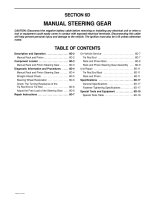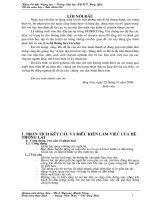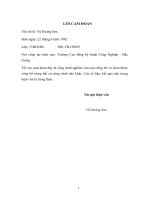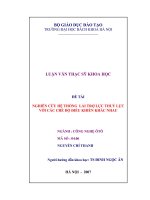Hệ Thống Lái Trợ Lực Tay Lái ĐiệnThủy Lực Electrically Powered Hydraulic Steering EPHS
Bạn đang xem bản rút gọn của tài liệu. Xem và tải ngay bản đầy đủ của tài liệu tại đây (1.26 MB, 14 trang )
Electrically Powered Hydraulic
Steering EPHS
SP34_13
The new EPHS (Electrically Powered
Hydraulic Steering) system manufactured
by TRW Chassis Systems is used for the
first time within the Group in the ŠKODA
FABIA.
The new steering system, while retaining
the excellent steering properties of the
conventional hydraulic power steering,
offers a wide range of advantages.
This system is used in the ŠKODA FABIA
on models fitted with 14” and 15” running
gear.
It is available as a left-hand drive and righthand drive version.
2
Advantages of the electrically powered
hydraulic steering are:
Improvement in comfort,
easier operation when parking and
manoeuvring, while offering a taught
steering at high speeds (safety factor).
Fuel savings,
as the energy consumption is based on
demand - irrespective of the operating
state of the internal combustion engine.
In this self-study programme we wish to
familiarise you with the design and operation
of this steering system and provide you with
initial information regarding service.
GB
Contents
System Overview
4
Engine-Pump Unit
7
Power Steering Control Unit
8
Power Steering Sensor
9
Power Steering Gear
10
Service
12
Self-Diagnosis
14
Function Diagram
15
Service
Service
xxxxxxxxxxxxxxxx
FABIA
xxxxxxxxxxxxxxxx
FABIA
XXXXXXXXXXXXX
XXXXXXXXXXXXXXX
XXXXXXXX
XXXXXXXXXXXXX
XXXXXXXXXXXXXXX
XXXXXXXX
Service Service Service Service Service
xxxxxxxxxxxxxxxx
FABIA
XXXXXXXXXXXXX
XXXXXXXXXXXXXXX
XXXXXXXX
xxxxxxxxxxxxxxxx
FABIA
XXXXXXXXXXXXX
XXXXXXXXXXXXXXX
XXXXXXXX
xxxxxxxxxxxxxxxx
FABIA
XXXXXXXXXXXXX
XXXXXXXXXXXXXXX
XXXXXXXX
xxxxxxxxxxxxxxxx
FABIA
XXXXXXXXXXXXX
XXXXXXXXXXXXXXX
XXXXXXXX
Service
xxxxxxxxxxxxxxxx
FABIA
XXXXXXXXXXXXX
XXXXXXXXXXXXXXX
XXXXXXXX
You will find notes on inspection and maintenance,
setting and repair instructions in the Workshop
Manual.
GB
3
System Overview
Power steering sensor G250
Steering gear
Reservoir
Gear pump
SP34_17
Power steering control unit J500
Pump motor
The system pressure which is required for the
steering force assistance, is produced by a
hydraulic pump.
In the conventional power steering system,
familiar, for example, from the FELICIA and
OCTAVIA, this pump is driven directly by the
vehicle engine.
In other words, part of the power output of the
engine is therefore required for driving the
pump.
Engine speed is at its lowest, however, at the
moment at which the greatest servo
assistance is required for the steering - in
other words when parking or manoeuvring.
Consequently, the pump capacity must be
designed for such cases.
When the engine is operating at higher revs,
the pump capacity which is not required, is
dumped over a bypass.
In the new steering system, the hydraulics
continue assisting the human steering effort,
but the hydraulic pump - a gear pump - is
driven in this case by an electric motor, and is
therefore mechanically separate from the
vehicle engine.
The electrically powered hydraulic steering
system is similar to a conventional one.
The hydraulic control is also basically
identical.
A new feature is that the steering servo
assistance depends on the steering angle.
That is why a steering angle sensor is
provided additionally above the steering
housing, to detect the steering angle rate and
transmit this information to the electronic
control.
The steering angle information flows along a
sensor cable directly to the control unit.
In addition, the vehicle speed is detected in
the control unit for analysis.
This information flows over the CAN bus.
The overview on the page opposite shows the
system design.
4
GB
System overview, schematic
diagram
Note:
The system overview is not the
electrical connection diagram.
Refer to the function diagram for this
information.
Vehicle speed
sender
Engine control unit
Control unit in dash
panel insert J285
Servotronic
warning lamp K92
Gear pump
CAN
Pressure limiting valve
Engine speed signal
Hydraulic fluid
reservoir
CAN
Non-return valve
Vehicle speed signal
Signal of steering
angle rate
CAN
Power steering
sensor G250
Power steering
control unit J500
Power steering terminal +30
Power steering terminal +15
Earth
–
M
Pump motor
SP34_05
Technical data
System pressure max. 10 ± 0.4 MPa (100 ± 4 bar)
Power demand max. 70 A
Volume flow at max. pressure and corresponding
steering angle rate 3 l/min
Power demand in standby mode 2.5 A
Volume flow at 0˚ steering angle 2 l/min max.
i.e. at v > 0 km/h, Q < 2 l/min.
Operational readiness –40 to 100˚C
GB
5
System Overview
Average power consumption in [watts]
Advantages of the electrically
powered hydraulic steering
600
500
400
300
200
100
0
SP34_16
Standard power
steering
EPHS
Driving on motorway
Driving on main road
Driving in town
In comparison to the traditional conventional
power steering system, as used in the FELICIA
and OCTAVIA, the newly developed
electrically powered hydraulic steering offers
a wide range of benefits:
–
Energy savings of as much as 85 %
– Enhanced environmental compatibility as a
result of reduced energy demand and
energy input, as well as a smaller volume
of oil in hydraulic system.
–
–
6
Realistic driving cycles produce fuel
savings of about 0.2 ltr./100 km in
comparison with a conventional system.
When driving only on motorways, a
conventional power steering system produces
a high power loss at the bypass valve because
of the high engine revs, in other words the
power steering pump supplies an excess
volume flow at low steering angle rates and
high engine speeds.
The new electrically powered hydraulic
steering system offers the greatest savings as
a result of the low steering angle rate when
driving on fast roads and from the fact that the
volume flow is matched to the vehicle speed.
Even driving in towns, it is still possible to
achieve significant savings (refer to chart).
Improvement in active safety as the
steering is easier to operate when parking,
while taught at high speeds.
GB
Engine-Pump Unit
The motor-pump unit
The motor-pump unit is a self-contained
component.
A special bracket for the motor-pump unit is
bolted to the longitudinal member, in the left
of the engine compartment, between bumper
and wheelhouse.
The motor-pump unit is flexibly mounted in
rubber bushings on the bracket and
surrounded by a noise-absorbing
encapsulation.
SP34_18
Screw cap
The motor-pump unit combines the following
components:
–
the hydraulic unit with gear pump,
pressure limiting valve and electric motor,
–
the reservoir for the hydraulic fluid,
–
the power steering control unit.
Reservoir
Return-flow
connection
The motor-pump unit requires no
maintenance. It is lubricated internally by the
hydraulic fluid.
It cannot be dismantled and no provision is
made for repairs.
A pressure line connects the pump to the
power steering gear.
Gear pump
Pressure hose
connection
The return-flow line of the hydraulic fluid
merges into the reservoir.
Rubber bushing
Power steering
control unit
Electric motor
GB
SP34_14
7
Power Steering Control Unit
The power steering control unit
J500
is part of the engine-pump unit.
Incoming signals
–
–
–
Engine speed (internal combustion engine)
Vehicle speed
Steering angle rate
Task
Converting the signals for powering the gear
pump in line with the steering angle rate and
vehicle speed.
CAN
C
H1
H2
0
Extended functions
–
–
SP34_23
Temperature protection for power steering
Reactivate protection after faults
Self-diagnosis
The control unit detects faults during
operation and stores these in a permanent
memory.
Pump function
Ignition
Vehicle engine
Pump
Steering servo
assistance
on
running
running
present
off
not running, vehicle
speed = 0
not running
none
Vehicle
speed
Steering angle
rate
Delivery
Steering servo
assistance
low e.g. parking
high
high
high
(light steering)
high e.g. motorway
low
low
low
(taught steering)
Steering servo assistance
8
GB
Power Steering Sensor
Task
The power steering sensor G250 is located at
the top in the steering gear and surrounds the
input shaft of the steering gear. It detects the
steering wheel angle and computes the
steering angle rate. It is not an absolute angle
sensor (steering wheel angle proportional to
steering wheel lock)!
Analysis of signal
SP34_19
The signal is required in the power steering
control unit in order to detect steering
movements.
The greater the steering angle rate, the greater
is the pump speed and thus the volume flow
(ignoring the vehicle speed).
Substitute function
If the sensor fails, the power steering moves
into a programmed emergency mode.
The steering function is assured.
The steering is slightly heavier to operate.
Self-diagnosis
Power steering
sensor
SP34_08
Input shaft
The sensor is integrated in the self-diagnosis.
The power steering control unit stores
malfunctions of the sensor.
30
30
15
15
In the function 02 - Interrogating fault memory it is possible to detect
– short circuit to earth
– open/short circuit to positive
– faults
CAN L
CAN L
CAN H
CAN H
S
CAN
J500
Electrical circuit
G250
J500
CAN
+31 + 5
Power steering sensor
Power steering control unit
15
+
M
-
G250
31
31
SP34_10
GB
9
Power Steering Gear
Initial position
Vehicle running straightahead
Engine running
Pump motor running
Gear pump delivering
Operating principle
The pressurized oil flows from the gear pump
along the pressure line to the hydraulic
control unit in the mechanical steering gear.
SP34_03
Power steering sensor
b
Return flow
c
Feed from gear pump
Non-return valve
d
Note:
From a hydraulic aspect, the function
positions of “right lock” and “left
lock” are similar to the familiar power
steering. Read more on this in SSP 14.
10
a
In the same way as in the conventional power
steering system, there is a torsion bar in the
hydraulic control unit which is connected at
the one side to the rotary slide, and on the
other side to the drive pinion and to the
control sleeve.
GB
Torsion bar
Rotary slide
Control sleeve
b
to power cylinder on left
d
from pump
a
c
to power cylinder on right
Return flow
SP34_07
Hydraulic control unit - schematic diagram
SP34_04
When driving straightahead, the torsion bar
holds the rotary slide and control sleeve in the
Neutral position. The power steering sensor
does not detect any steering angle.
The hydraulic fluid flows practically
pressureless through the hydraulic control
unit along the return-flow line and back to the
reservoir.
GB
11
Service
Service
The electrically powered hydraulic steering is
maintenance-free.
No new special tools are required.
No provision is made for repair work on the
power steering gear or on the motor-pump
unit. The causes for problems can be detected
by carrying out the pressure and leak test, as
well as self-diagnosis. If a problem exists, the
power steering gear or the motor-pump unit
should be replaced.
The following parts of the steering gear may
be replaced:
Track rod end, track rod, boot, clamp, spring
strap clamp, seal (sealing power steering gear
to body), clamp, rubber insert and power
steering sensor G250.
SP28_04
Note:
When replacing the track rod ends,
pay attention to the marking by
means of letters on the end.
Left track rod end
If correctly installed, the track rod end
must be angled to the rear and the
stud of the track rod end facing up.
Carry out a check of chassis
alignment.
Right track rod end
SP34_15
The following parts may be replaced at the
motor-pump unit:
Bracket, rubber bush, noise encapsulation and
screw cap with dipstick.
Reactivate protection
The motor-pump unit features a reactivate
protection after a fault, failure or a crash.
The reactivate protection can be cancelled by
switching the ignition off and starting the
engine again.
12
If the unit has overheated, wait, if necessary,
15 minutes to allow it to cool down.
If it is not possible to cancel the reactivate
protection by starting the engine after this
waiting time, there is a fault in the vehicle
electrical system, or the motor-pump unit is
faulty.
In such cases, carry out self-diagnosis.
GB
Power
steering gear
Pressure line and return-flow line
When reconnecting the pressure line or
return-flow line, replace the existing seals and
clamps.
Return-flow line
Note:
Each time the pressure line is
disconnected at the power steering
gear, the banjo bolt and non-return
valve should be replaced. On no
account use the banjo bolt without a
non-return valve.
Fit only a genuine replacement part.
Avoid stresses and bends in the hydraulic lines.
SP34_20
Pressure line
Banjo bolt with
non-return valve
Subframe
Inspecting hydraulic fluid level
The hydraulic fluid level can be inspected with
the aid of the dipstick at the screw cap of the
reservoir.
–
When hydraulic fluid is cold:
in area of lower marking
–
When hydraulic fluid is warm (from engine
temperature of about 50 ˚C):
approximately in the middle between
bottom and top markings
top marking
bottom marking
SP34_22
Screw cap with
dipstick
Hydraulic fluid
reservoir
Note:
Detailed information on the service
aspect can be found in the Workshop
Manual Running Gear and in the
Inspection and Maintenance binder.
GB
SP34_21
13
Self-Diagnosis
The system
Diagnosis communication flows over the
CAN. The gateway converts the signals from
CAN to the K cable.
Self-diagnosis relates to the electrical and
electronic parts of the power steering system.
The control unit detects faults during
operation and stores these in a permanent
memory. This information is also retained
even if there is no battery voltage.
Sporadic faults are not stored in the
permanent memory.
Servotronic warning
lamp K92
The warning lamp
After the ignition is switched on, the
Servotronic warning lamp -K92- comes on. An
internal check cycle is completed during this
period.
If the warning lamp does not go out after the
engine is started and after completion of the
check cycle, this indicates that faults may be
stored.
Faults may be defects in the electrical system.
SP34_06
The self-diagnosis
It is necessary to switch on the ignition first in
order to initiate self-diagnosis.
Self-diagnosis can be performed with the
vehicle system tester V.A.G 1552, the fault
reader V.A.G 1551 or the vehicle diagnosis,
measuring and information system VAS 5051.
It is initiated with the address word
44 - Power steering
Available functions
01 02 05 06 07 08 -
14
Interrogating control unit version
Interrogating fault memory
Erasing fault memory
Ending output
Coding control unit
Reading measured value block
SP33_73
GB
Function Diagram
30
30
15
15
CAN L
CAN L
CAN H
CAN H
S
K92
J519
J533
CAN
J500
CAN
15
+
M
+31 + 5
J
J285
-
+15
G250
G22
31
31
SP34_09
The function diagram provides a simplified
representation of the linkages of the system
components of the “electrically powered
hydraulic steering” with other system
components of the vehicle.
Communication takes place in this case over
the drive CAN.
Legend
G22
G250
J…
J285
J500
J519
J533
K92
S
Vehicle speed sender
Power steering sensor
Engine control unit
Dash panel insert control unit
Power steering control unit
Vehicle electrical system control unit
Gateway
Servotronic warning lamp
Fuse
Positive
Note:
The function diagram is not a current
flow diagram.
Negative
Output signal
Input signal
CAN (output and input signals)
GB
15









